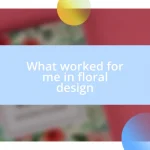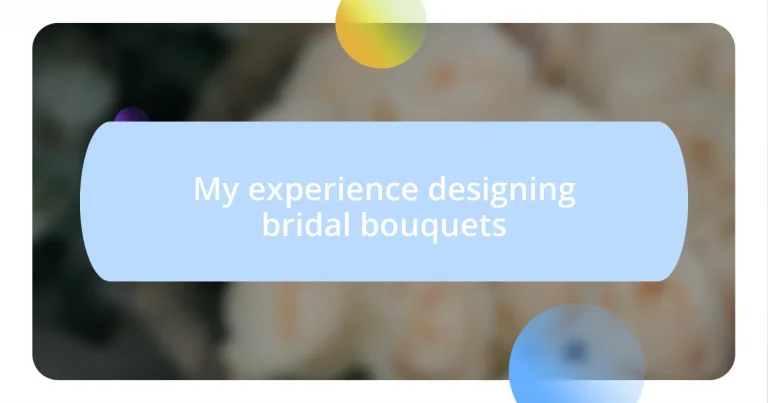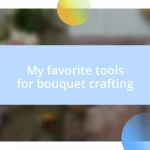Key takeaways:
- Understanding the symbolism, size, shape, and color coordination of flowers is crucial for creating a bridal bouquet that reflects the bride’s personality and complements the wedding theme.
- Choosing the right flowers should consider seasonality, symbolism, color palette, fragrance, and personal connections to enhance the bouquet’s emotional significance.
- Personalization techniques, such as incorporating meaningful items and colors, along with addressing common challenges in bouquet design, can elevate the overall experience for the bride.
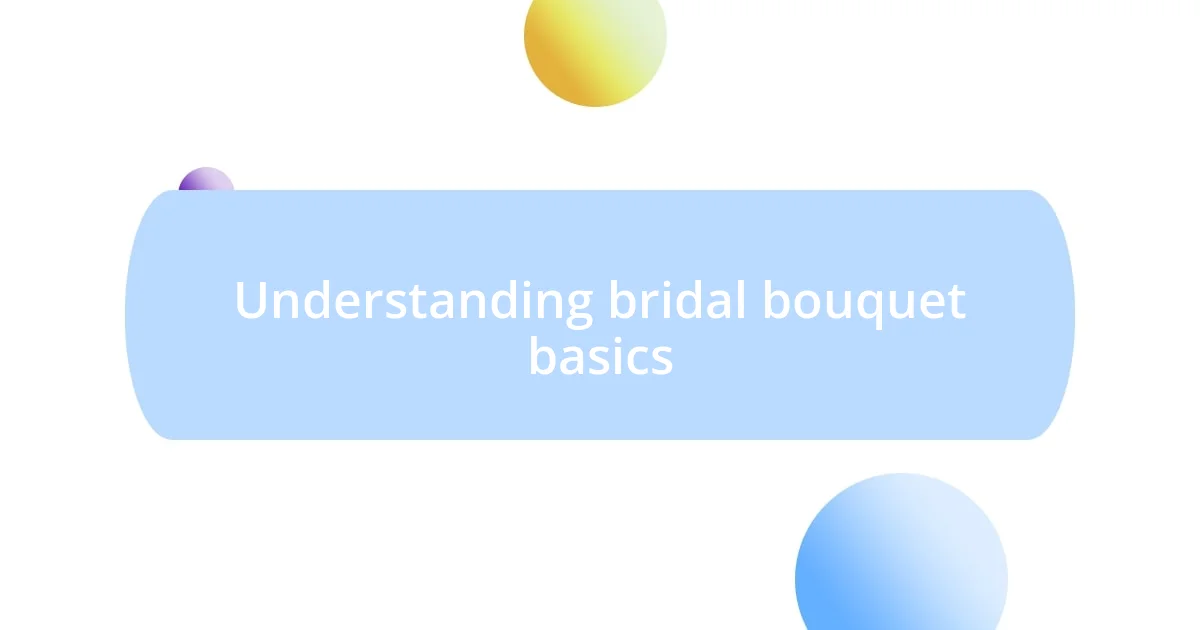
Understanding bridal bouquet basics
When it comes to bridal bouquets, understanding the basic components is essential for creating a stunning arrangement. I remember selecting the first bouquet I designed; the sheer joy of choosing flowers that reflected the bride’s personality was exhilarating. Did you know that flowers have their own meanings? For instance, roses symbolize love, while lilies represent purity. Knowing these meanings can add a deeper emotional layer to your design.
The size and shape of the bouquet play crucial roles as well. I often find that couples prefer a style that complements their overall wedding theme, such as a cascading bouquet for a romantic vintage wedding or a sleek, modern design for a contemporary celebration. Have you ever thought about how the bouquet’s size can impact a bride’s silhouette in her dress? A well-proportioned bouquet can enhance her beauty, making it an important consideration in the design process.
Color coordination is another fundamental aspect. I vividly recall working with a bride who had a specific color palette in mind. It was exciting to mix and match blooms, ensuring everything harmonized perfectly. Do you ever feel overwhelmed by choices? That’s completely normal! Focusing on the emotions and themes you want to represent can help guide your selections, making the process enjoyable rather than daunting.
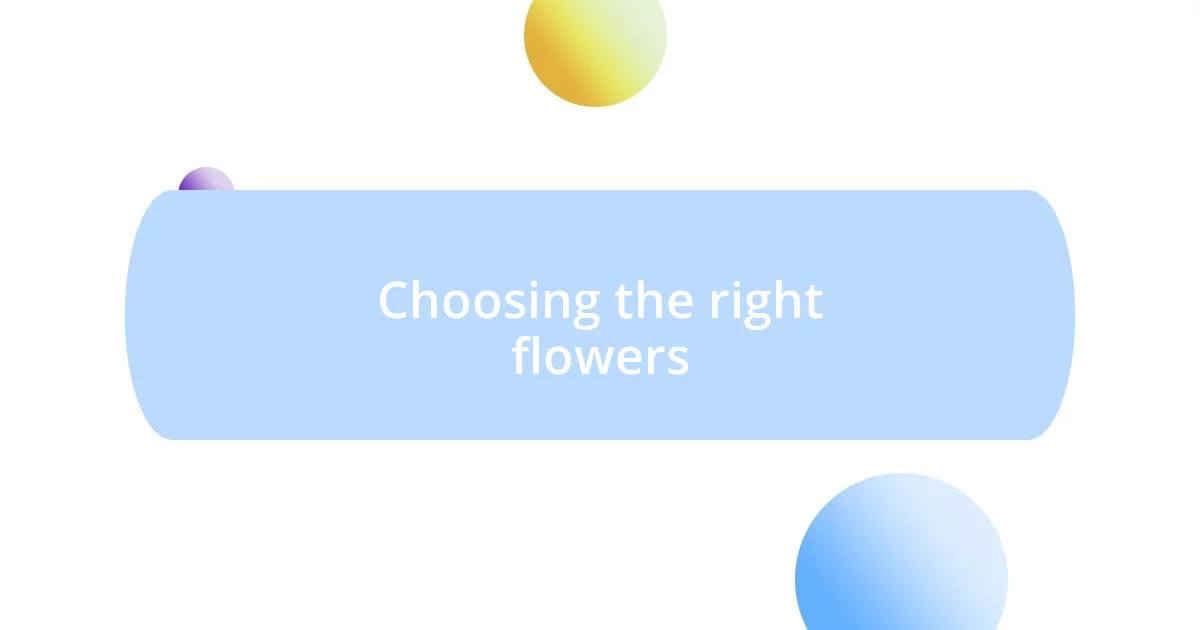
Choosing the right flowers
Choosing the right flowers is truly a delightful journey. I remember one particular bride who dreamed of a soft pastel bouquet to match her beach wedding. As we discussed her vision, it became clear that we needed delicate blooms like peonies and sweet peas to evoke that breezy, romantic vibe. Selecting flowers that resonate with the couple’s story can transform a bouquet from ordinary to extraordinary.
When considering your flower choices, keep these tips in mind:
- Seasonality: Opt for flowers that are in season for optimal freshness and cost-effectiveness.
- Symbolism: Think about the meanings behind flowers to add a sentimental touch. For instance, including hydrangeas for heartfelt gratitude can be a lovely nod.
- Color Palette: Choose colors that align with the wedding theme or bridal attire to ensure a cohesive look.
- Fragrance: Don’t forget the scent! Flowers like gardenias can add an olfactory dimension to the bouquet experience.
- Personal Connection: Incorporate flowers that hold a special meaning for the couple. Perhaps they shared a moment at a garden filled with tulips, making them a perfect choice.
These considerations not only enhance the bouquet’s visual appeal but also create meaningful ties to the couple’s journey together.
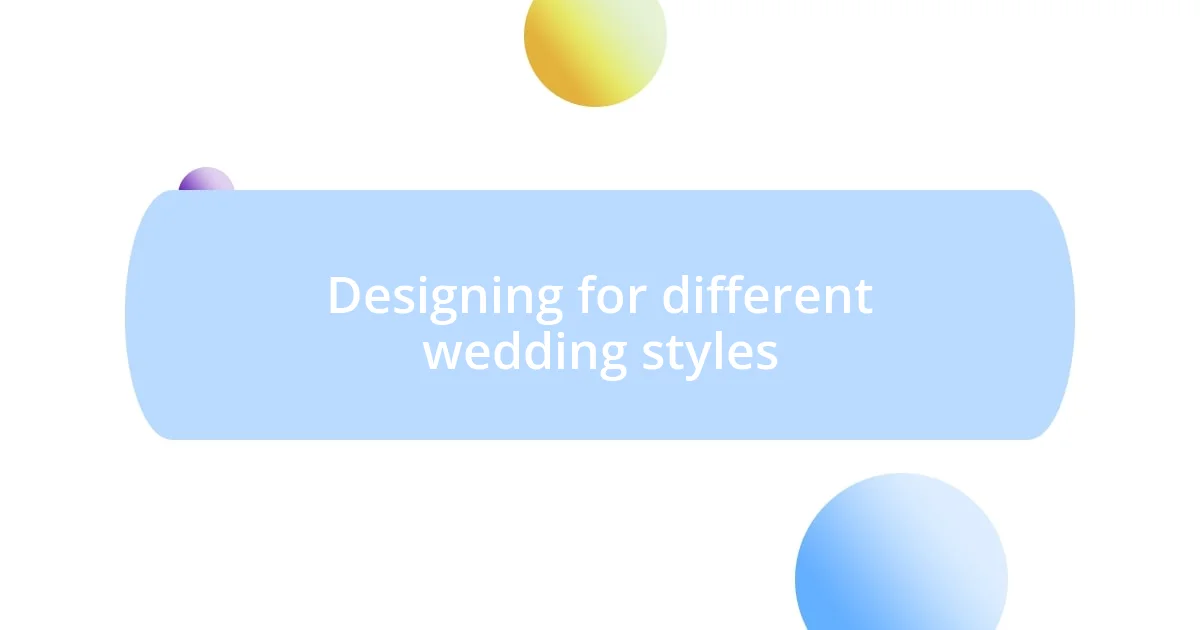
Designing for different wedding styles
Designing for different wedding styles requires a keen understanding of the theme, ambiance, and the couple’s personality. I recall working on a rustic wedding where we opted for wildflowers, incorporating sunflowers and dahlias. This choice really embodied the couple’s love for nature, giving their bouquet a relaxed and free-spirited feel. Interestingly, I’ve found that examining a couple’s style can reveal so much about their relationship. For example, a glamorous wedding could feature embellished bouquets with glittering accents, contrasting beautifully with a bohemian theme.
In my experience, each wedding style brings its own unique challenges and inspirations. For a classic ceremony, traditional blooms like garden roses and hydrangeas can provide an elegant touch. I once designed a bouquet with blood-red roses and white peonies for a couple whose love story was steeped in timeless romance. That bouquet not only captured their aesthetic but also told their story. How incredible is it that a bunch of flowers can evoke such deep emotions?
The table below provides a quick comparison of bouquet designs suitable for various wedding styles to inspire your choices:
| Wedding Style | Suggested Bouquet Design |
|---|---|
| Rustic | Wildflowers, sunflowers, and twine accents |
| Glamorous | Large blooms with embellishments and deep colors |
| Classic | Garden roses and hydrangeas with lush greenery |
| Bohemian | Asymmetrical arrangements with seasonal blooms and texture |
| Beach | Light, airy flowers like orchids and peonies with flowing ribbons |
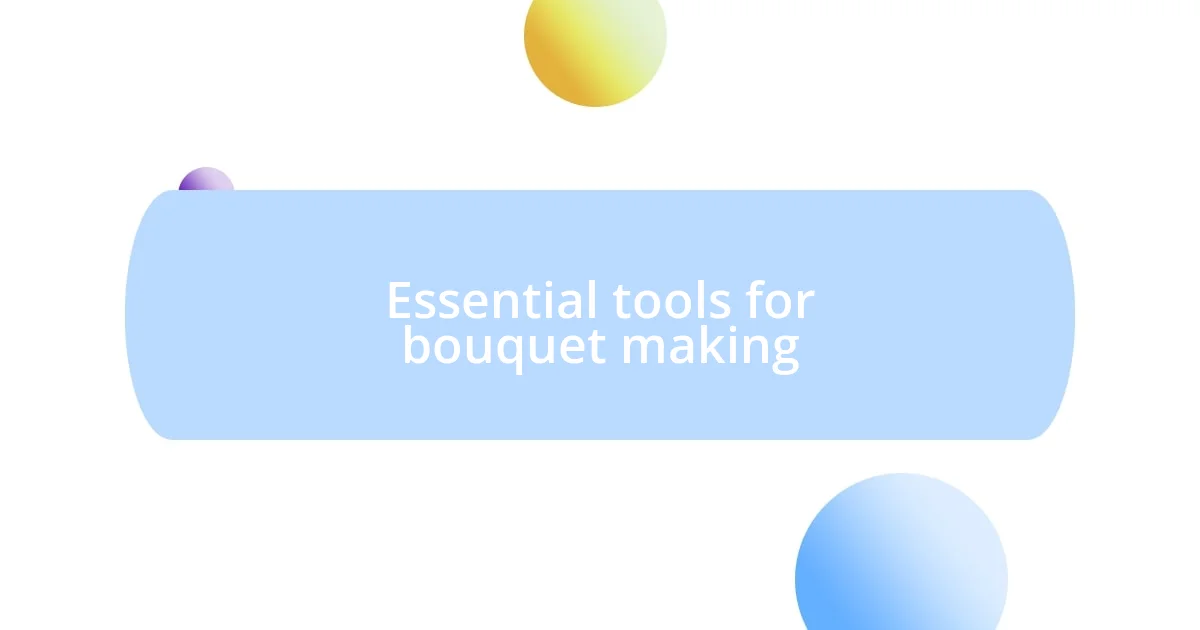
Essential tools for bouquet making
When it comes to crafting the perfect bridal bouquet, having the right tools at your disposal can make all the difference. I remember my early days as a florist, fumbling through techniques without the perfect set of tools. After a few trials, I quickly learned that sharp floral shears are essential—they allow for clean cuts, which are crucial for keeping flowers fresh longer. Without them, you risk crushing stems and losing precious water uptake.
Another indispensable tool is floral tape, which I initially overlooked. I learned its importance during a wedding where I needed to secure a delicate hand-tied bouquet. The tape not only helped keep the flowers in place but also concealed the mechanics, giving it a polished look. As I wrapped those stems tightly, I could almost feel the bride’s excitement radiating through the design process. Can you imagine attaching a bouquet without that sturdy support?
Finally, a good quality floral foam can work wonders, especially for those larger arrangements. I recall a time when I used this foam for a lavish wedding centerpiece; it allowed me to create a stunning waterfall of blooms that truly took everyone’s breath away. This tool provides an excellent foundation, allowing the flowers to stay hydrated and secure. It’s fascinating how the right tools can elevate your designs, isn’t it?
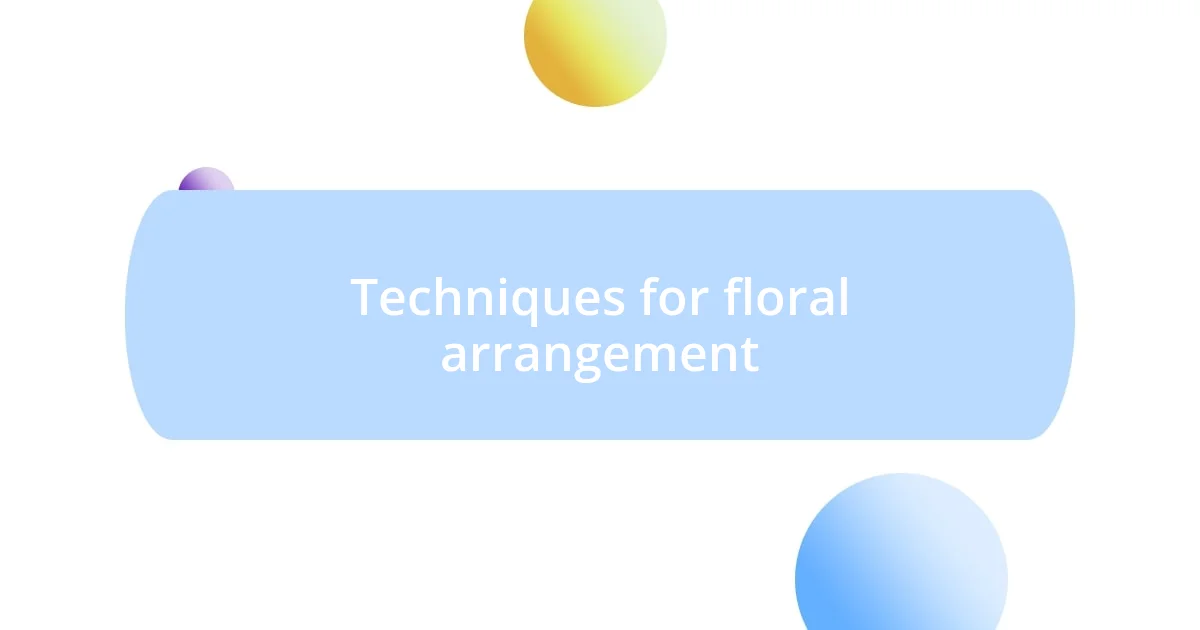
Techniques for floral arrangement
One of the key techniques I’ve embraced in floral arrangement is the spiral method, especially for bridal bouquets. This technique involves gathering flowers and rotating them in a spiral as you build the bouquet. I remember the first time I used this method for a bride who loved classic elegance. Watching her eyes light up as I created a perfectly balanced arrangement of calla lilies and freesia was exhilarating. Do you see how the spiral can create both structure and fluidity in your designs?
I also swear by color theory when working with bouquets. Understanding complementary colors can make or break an arrangement. For example, I once designed a vibrant bouquet for a summer wedding with bright pink peonies and bold orange dahlias. The colors popped against the backdrop of deep green foliage, creating a visual feast that resonated with the couple’s joyful personalities. It’s amazing how color can evoke emotions—don’t you think?
Another technique I’ve found invaluable is the layering of textures. Combining different flower types, such as the smoothness of roses with the feathery touch of sweet pea, creates depth and intrigue. I recall a particular autumn wedding where I incorporated textured elements like thistles and eucalyptus alongside soft dahlias. The combination was a sensory delight, capturing the essence of the changing seasons. How does texture play a role in your perception of a bouquet? It’s something that can transform a simple design into something truly captivating.
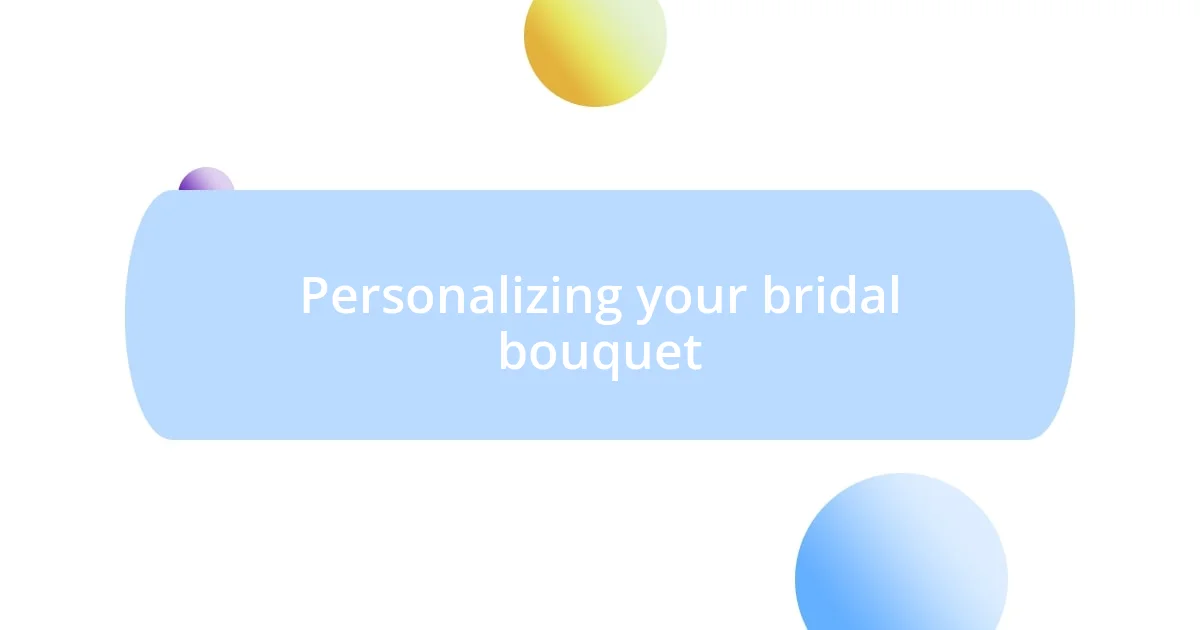
Personalizing your bridal bouquet
Personalizing your bridal bouquet is all about infusing your unique story into the design. I once worked with a bride who wanted to incorporate her grandmother’s brooch into her bouquet. As I delicately pinned it among the blooms, I could feel the emotion in the air—it was as if the bouquet became a cherished family heirloom. Have you considered how personal items can add that special touch?
I’ve also learned that using flowers with significant meanings can enhance the bouquet’s emotional weight. For instance, during a spring wedding, I included fragrant lavender for one bride, who associated its calming scent with childhood memories of her grandmother’s garden. As she walked down the aisle, the aroma filled the air and elicited smiles from all her loved ones. Isn’t it incredible how a simple flower can evoke such strong memories?
Another way to personalize your bouquet is through color choices that reflect your personal style. I remember a bride with a deep love for vintage aesthetics; she chose muted tones of dusty pink and soft peach, reminiscent of vintage photographs. As I arranged those blooms, I thought about how colors can tell a story and reflect the season of love. What colors resonate with your journey?
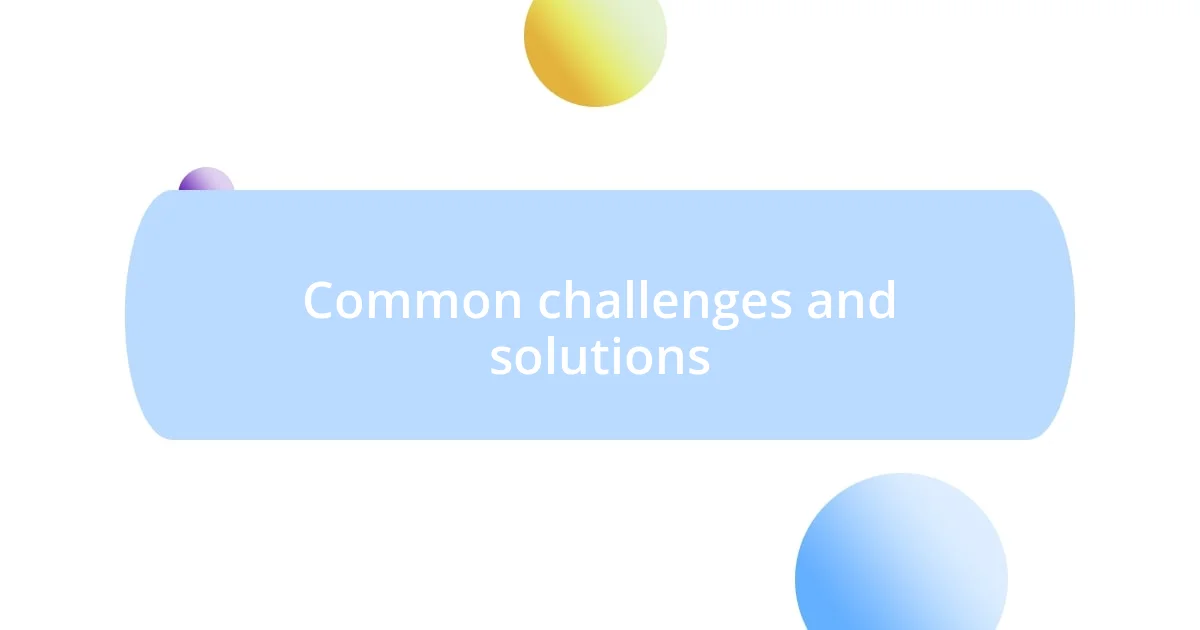
Common challenges and solutions
When designing bridal bouquets, one common challenge I often encounter is the balance between aesthetics and practicality. I recall a time when a bride insisted on using delicate peonies, unaware that they can be quite fragile. To address this, I cleverly layered sturdier flowers like hydrangeas at the base, offering support while still showcasing the peonies above. Isn’t it interesting how a little foresight can transform a potential disaster into a stunning masterpiece?
Another hurdle is accommodating last-minute changes from clients—something I’ve learned all too well. I remember a bride who decided to swap out her chosen flowers just days before the wedding. It was a stressful moment, but I calmly offered alternative blooms that matched her vision while ensuring they remained seasonally appropriate. Adaptability really is key in this line of work; don’t you think that being flexible can turn a challenge into an opportunity for creativity?
Timing is another significant concern in bouquet design. Fresh flowers can wilt if not handled properly, and I always emphasize the importance of preparation. For instance, on one occasion, I prepped several bouquets for a wedding, storing them in a cool place overnight to keep them fresh. I found that having a backup plan and being organized can really save the day. What strategies do you use to tackle time constraints in your projects? It’s all about finding what works best for you.


